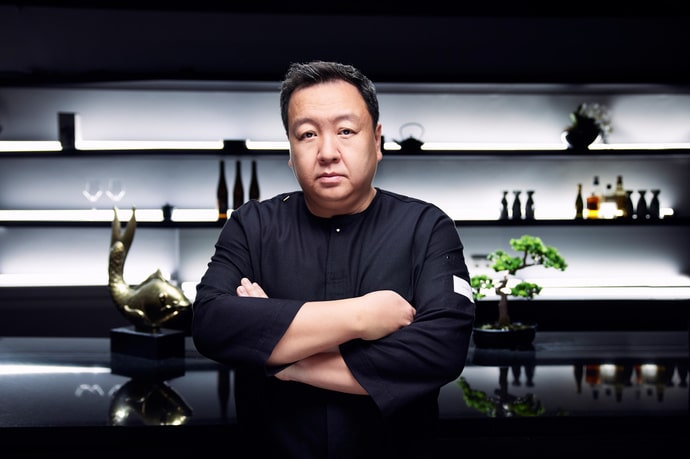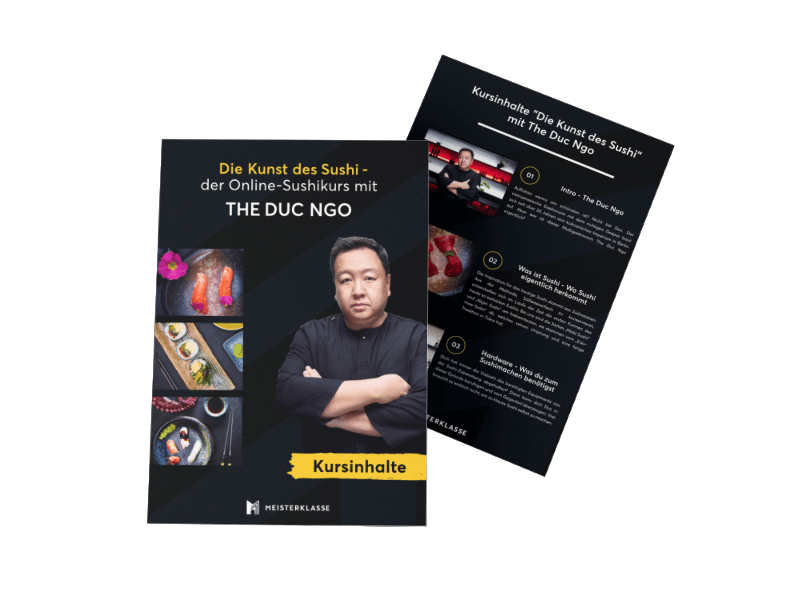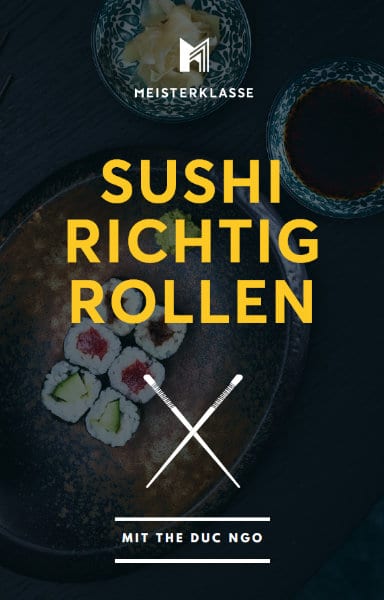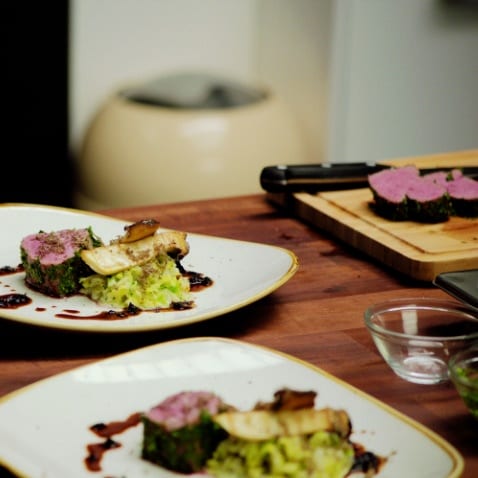
Die Kunst des Sushi
Lerne die besten Techniken für das perfekte Sushi daheim.
Mit 30 Tage Geld-zurück-Garantie
Only available in German language

The Duc Ngo
The Duc Ngo ist wahrscheinlich Deutschlands bekanntester asiatischer Gastronom und namhafter Sushi-Koch seit über 25 Jahren. Von 1999 bis heute hat er in Berlin und Frankfurt über 14 erfolgreiche japanische, vietnamesische und pan-asiatische Restaurants aufgebaut. Neben zahlreichen TV-Auftritten, wie z.B. bei Kitchen Impossible mit Tim Mälzer wurde er dieses Jahr in die Top 50 der “Best Chefs Awards” des Rolling Pin Magazin gewählt.

Die Kunst des
Sushi mit The Duc Ngo
Produziert in Kinoqualität
Unbegrenzter Zugang

Alle Inhalte der Meisterklasse zum Nachlesen
Als PDF zum Download und Ausdrucken

Für deine absolvierte Meisterklasse
Unterschrieben von The Duc Ngo

29 Rezepte zum nachmachen,
Schritt für Schritt erklärt
von den Klassikern bis hin zu
den Signature Rolls

Lerne die besten Techniken,
Tipps und Tricks
für frisches Sushi zuhause

Selbstbestimmtes Lerntempo
An jedem Ort, zu jeder Zeit,
Per PC, Tablet oder Handy
Zugang zur exklusiven Community
Mit 30 Tage Geld-zurück-Garantie
Inhalte
Aufhören wenns am schönsten ist? Nicht bei Duc. Der vietnamesische Gastronom mit dem richtigen Gespür baut sich seit über 20 Jahren sein kulinarisches Imperium in Berlin auf. Aber wer ist dieser Multigastronom The Duc Ngo eigentlich?
Die Inspiration für das heutige Sushi stammt aus Südostasien. Aus der Methode, Süßwasserfisch zu konservieren, entwickelten sich im Laufe der Zeit die ersten Formen des heute so beliebten Sushis. Bei uns sind die Sorten „Maki Sushi“ und „Nigiri Sushi“ am bekanntesten, sie stammen vom „Edo-mae-Sushi“ ab, welches seinen Ursprung und eine lange Tradition in Tokio hat.
Dich hat immer die Vielzahl des benötigten Equipments von der Sushi-Zubereitung abgehalten? Dann kann dich Duc in dieser Episode beruhigen und vom Gegenteil überzeugen: Viel braucht es wirklich nicht, um zu Hause Sushi selbst zu machen.
Das Schleifen japanischer Messer auf einem Schleifstein ist einfacher als viele denken. Da es sich um einen einfachen V-Schliff handelt, ist ein Nachschleifen nur eine Frage des richtigen Winkels und einer ruhigen Hand. Duc zeigt dir in dieser Episode, wie du mit der richtigen Vorbereitung, Haltung und dem passenden Winkel den perfekten Schliff hinbekommst.
Essenziell für ein perfektes Sushi ist frischer Fisch. Prinzipiell kann fast jeder Fisch zur Zubereitung von Sushi verwendet werden. Freue dich u.a. auf Blauflossen Thunfisch, Makrele, Jakobsmuschel, Seebrasse und Oktopus.
Sushi Reis zubereiten ist eine Kunst für sich und Sushi Köche verbringen Jahre damit diese zu perfektionieren. Der perfekte Sushi Reis sollte klebrig genug sein, sodass die Rollen am Ende nicht auseinander fallen, gleichzeitig aber auch locker und fluffig bleiben. Duc präsentiert dir in dieser Episode, wie du ohne Reiskocher, ganz einfach den leckersten Sushi Reis zubereiten kannst.
Sushi selbst zu machen ist viel leichter als die meisten denken. Einen Großteil der Zutaten fürs selbstgemachte Sushi bekommt man in jedem größeren Supermarkt, auf dem Wochenmarkt, beim Fischhändler oder im asiatischen Lebensmittelhandel. Duc zeigt dir, wie leicht du das japanische Essen selbst zubereiten kannst und dass deiner Kreativität hierbei keine Grenzen gesetzt sind.
Übungsunterlagen
Fisch filetieren und von Gräten, Flossen und Haut befreien – klingt doch ganz einfach! Also keine Scheu vor ganzen Fischen. Wenn du weißt, wie du das Messer ansetzt, wo das Filet sitzt und worauf du achten solltest, kannst du Thunfisch, Lachsforelle, Makrele oder Jakobsmuschel prima selbst filetieren.
Jetzt wird gerollt! Hoso-Maki heißt übersetzt “dünne Rolle“. Bei dem Hoso-Maki wird ein Noriblatt halbiert und meist mit nur einer bis maximal zwei Zutaten gefüllt. Dazu wird traditionell Sojasauce gereicht. Die mundgerechten Happen dippt man übrigens nur mit dem Algenblatt und nicht mit der Füllung in die Sojasauce.
Ura Maki – Diese Maki sind auch unter dem Namen Inside-Out oder California-Rolls bekannt. Dabei werden die Zutaten, wie Fisch und Gemüse, direkt vom Noriblatt umhüllt und der Reis befindet sich außen an der Rolle. Meist wird der Reis dann mit Sesam oder Fischeiern dekoriert. Einfach so unglaublich LECKER!!!
Futo-Maki (übersetzt: “dicke Rolle“) ist die große Variante der Maki Rolle. Futo-Maki werden aus einem ganzen Noriblatt hergestellt, das mit Reis, Fisch und Gemüse gefüllt wird. Bei Futomaki befinden sich mindestens 3 oder mehr Füllungen in der Rolle. Auf die Plätze, rollen, los!
Für Nigiri Sushi wird der Sushi Reis von Hand zu kleinen, ovalen Bällchen geformt. Auf das Bällchen kommt meist ein Streifen roher Fisch, Meeresfrüchte, Tamago oder Kaviar. Und wie immer gilt: Deiner Kreativität sind keine Grenzen gesetzt!
Nigiri formen step by step – in dieser Episode wird Duc dir eine weitere Variante mit gekochten Meeresfrüchten zeigen.
Dem japanischen Ei auf der Spur – Tamagoyaki (jap. 卵焼き wörtlich: gebratenes Ei) ist in der japanischen Küche ein gerolltes Omelett. Es wird gern als Belag für Sushi verwendet und ist ein beliebtes Gericht, welches mit Mirin, Sojasauce und Zucker gewürzt wird. Lass dich von dieser leckeren Sushi Zutat überraschen.
Gunkan Makis gehören zu den Nigiri Sushis. Diese heißen übersetzt auch “Kriegsschiff-Rollen-Sushi”, was auf die Optik zurückzuführen ist. Die handgeformten Reisrollen werden in schmalen Noriblättern eingewickelt. Das Schiffchen wird oft mit Fischeiern wie Fliegenfischkaviar gefüllt.
Temaki ist ein japanisches Sushi, das einfach per Hand zur Tüte geformt wird. Das Wort “Temaki” bedeutet passenderweise: “von der Hand eingerollt“. Schnell belegt und im Handumdrehen aufgerollt. Die leckeren Temaki Sushi Tüten füllst du ab sofort ganz easy mit deinen Lieblingszutaten.
Sushi ist vielfältig und es gibt immer wieder neue Abwandlungen. Mit den Zutaten wird immer öfter experimentiert und es werden neue Geschmackskombinationen ausprobiert. Es gilt das Motto: Erlaubt ist, was schmeckt!
In der japanischen Küche genießt man sehr oft Sashimi. Dies ist in dünne Scheiben geschnittener roher Fisch oder andere Meeresfrüchte. Die Japaner essen mehrere Fischarten roh, Sashimi ist dabei meistens eine Vorspeise. Duc zeigt dir in dieser Episode seine Königsdisziplin.
Die My Best Friend’s Rolls sind knusprig warme Gemüse Tempura mit Lachs. Die hausgemachte würzig-süße Kuchi-Sauce und die sahnige Mayonnaise sorgen zusammen mit der scharfen Kresse bei diesen Inside Out Rolls für ein cremig-süß-scharfes Geschmackserlebnis.
Dragon Roll und Spicy Tuna Roll – In dieser Episode zeigt dir Duc, wie du seine Extreme Rolls zu Hause nachmachen kannst! Neben den California Rolls ist die Dragon Roll ein weiteres beliebtes Sushi, das in modernen Sushi-Restaurants serviert wird.
Reisröllchen im neuen Glanz – auch bei den California Rolls werden immer phantasievollere Füllungen und Kombinationen populär – ob mit Tempura-Garnele (kurz frittierte, knusprige Garnele), Rinderfilet, Kresse oder Papaya.
Sushi-Rollen werden in der Regel kunstvoll auf einer Platte arrangiert. Man sollte die Stücke so anordnen, als ob sie eine Landschaft darstellen wollen. Duc zeigt dir, wie das Sushi Teller Arrangement zum Kinderspiel wird.
Selbstgemachter Dashi-Fond – die Grundlage jeder Miso-Suppe! Traditionell wird die Brühe, die wie kaum etwas anderes für den typischen “Umami”-Geschmack steht, mit Bonito-Flocken und Seetang aromatisiert.
Mit den passenden Sushi Zutaten und dem richtigen Werkzeug kannst du ab jetzt selbstgemachtes Sushi auch ganz einfach zu Hause genießen. Viel Spaß dabei.
Du willst mehr über die Episoden und die Meisterklasse von The Duc Ngo erfahren?
Hol dir jetzt unser kostenloses Info-PDF zum Kurs inkl. eines Gratis-Rezepts von The Duc Ngo.
Beispiel Episode (Ausschnitt)
Reis und Essig
Was unsere Kunden sagen
Über die Kunst des Sushi - Der Online Sushikurs mit The Duc Ngo
Kaum ein anderer asiatischer Gastronom ist in Deutschland so bekannt wie The Duc Ngo. Mit seinen erfolgreichen Restaurants in Berlin und Frankfurt rangiert er bei den “Best Chefs Awards” unter den Top 50. Im Sushi Kurs erfährst Du mehr über den Meister und lässt Dich von ihm in die Kunst der Sushi-Zubereitung einführen.
Sushi machen will gelernt sein. Der Sushi Kurs online vermittelt Dir zunächst die nötigen Basics. Er behandelt das Schleifen japanischer Messer, bietet eine solide Warenkunde und zeigt Dir, wie man Fisch richtig zerlegt. Dazu verrät Dir der Meisterkoch das perfekte Sushi Reis Rezept, denn nur wer Sushi Reis kochen kann, kann auch Sushi zubereiten.
Beim Sushi Lernen wirst Du mit Begriffen wie Maki, Nigiri oder Sashimi vertraut werden. Mit viel Liebe zum Detail stellt Dir The Duc Ngo raffinierte Kreationen vor, die Dich zur Nachahmung inspirieren. Freue Dich auf Tamagoyaki mit gebratenem Ei, auf Gunkan Makis mit Fischeiern oder auf handgerollte Temaki-Tütchen!
Das Auge isst bekanntlich mit. Dem kunstvollen Arrangement von Sushi-Platten widmet der Meister deshalb ein eigenes Video. Mit den richtigen Zutaten und dem passenden Handwerkszeug kannst Du nach diesem Kurs Sushi selbst machen und weißt auch, wie Du den perfekten Sushi Reis zubereiten musst.
Mit 30 Tage Geld-zurück-Garantie
Hilfe / FAQ
→ Für den Kurs benötigt man kein spezielles Equipment. Empfohlen werden dennoch Bambusmatten für das Rollen der Sushi, scharfe Küchenmesser und Essstäbchen.
→ Die Zutaten, die im Kurs verwendet werden, bekommt man im Asia-Markt oder auch in gut sortierten Supermärkten mit Asia Abteilung. Frischen Fisch und Meeresfrüchte kann man ebenso an Frischetheken im Supermarkt oder bei Fachhändlern direkt kaufen.
→ Der Großteil der Gerichte beinhalten rohen Fisch. Dennoch können bei allen Sushi vegetarische Alternativen verwendet werden, die auch im Kurs genannt werden.
Weitere Fragen?
Finde weitere Informationen zu den Kursen und Abläufen bei der Meisterklasse.
Unser Partner





